

Home
The Mission
By any contemporaneous account, the Salinan Nation were a remarkable people! Paradoxically, the contributions they made to the building of early Colonial Central California Mission Culture and the legacy they left behind, so great and enduring, we fail to recognize the real people behind these remarkable feats.
This is their story in their own words.
The Salinan People
by Suzanne Pierce Taylor
Salinan elder and Playaño Salinan descendant
The Salinans, an ancient people that once populated what are now parts of San Luis Obispo and Monterey Counties are still here. We do not look the same, dress the same, live the same or speak the same, but we are here.
Scholars tell us that the Salinan language is from Hokan roots and said to be 6,000 to 8,000 years old, one of the oldest languages and people in California. There were three main dialects spoken, the people on the coast spoke the Playaño dialect, the people near Mission San Antonio spoke the Antoniaño version and those in the vicinity of Mission San Miguel spoke Migueleño. Since all three dialects had the same base, the people could communicate easily with one another.
During the mission era, Spanish was required and the priests commented on how quickly the people learned to speak it, so within a few generations the Salinan language was almost forgotten. By the time the language began to be recorded, much of it had been lost, but valiant efforts were made to preserve the remnants of the language with help from the last of the Salinan speakers in the late 1800s-early 1900s.
Salinans were among the first California natives to be impacted by Europeans. In 1602 the Spaniard Vizcaino, sailed up the California coast and spent time on shore near Monterey Bay. Before departing, the Carmelite priests with him told the natives that they would return one day. For over 171 years the people awaited the return of these "long robes". Then finally, in 1773, a very old woman, at least 100 years old appeared at Mission San Antonio asking to be baptized immediately. When asked why, she replied that she knew these were the long-awaited ones that her ancestors had spoken of. She was baptized and given the name Agata Maria. Her granddaughter is a Playaño Salinan, Margarita de Cortona, named in the mural on Mission San Antonio's wall recording the first marriage in California. Ethnologists say the coast people, the Playaño Salinans are extinct but my family knows better as we are direct descendants of them. This is documented in Mission San Antonio records and early history of the area.
Looking at the countryside, imagine how even more beautiful this Salinan
homeland was before "civilization", before highways, before fences.
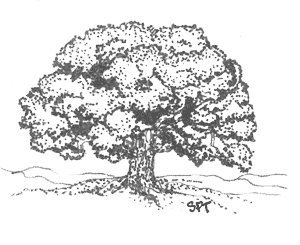 Early visitors to
California often remarked on how the land resembled a garden or park with large open
meadows and oak trees, free of brush and undergrowth. This was not accidental, the
people practiced "agriculture" by burning off the brush under the oak trees to expose the
ground where the acorns fell in the autumn. Often favorite medicinal herbs and food
plants were transplanted to the village sites to be conveniently near when needed.
Today these plants, such as the elderberry, can still be found growing near old middens
and village sites, testifying to the efforts of the ancient people. The people were taught
from infancy to take only what was needed, not to waste and to always leave seed for
the future.
Early visitors to
California often remarked on how the land resembled a garden or park with large open
meadows and oak trees, free of brush and undergrowth. This was not accidental, the
people practiced "agriculture" by burning off the brush under the oak trees to expose the
ground where the acorns fell in the autumn. Often favorite medicinal herbs and food
plants were transplanted to the village sites to be conveniently near when needed.
Today these plants, such as the elderberry, can still be found growing near old middens
and village sites, testifying to the efforts of the ancient people. The people were taught
from infancy to take only what was needed, not to waste and to always leave seed for
the future.
The Salinans were a peaceful, generous, family-oriented people. A priest remarked that they practiced the golden rule of "treat others the way you want to be treated" in their wild state, before becoming Christianized and they were happy to share what little they had. Salinans generously shared food with Portola's hungry men.
Among these placid people, differences that arose were soon settled. "Wars" lasted only a few days as this was a people that valued life. They did not have a war- oriented society, or a value structure that glorified war, their weapons were designed for hunting food, not for killing humans. The goal was to put the adversary out of action, not kill him. And because they did not have experience in conquering or being conquered, it made them more vulnerable to outsiders with combatant histories.
The Salinans lived a simple life, usually filled with the daily activities of hunting
and gathering food, preparing it, preserving it and enjoying it. Eating was and still is a
very social event among the people. A priest recorded that they did relish their food and
liked to eat throughout the day rather than at set mealtimes. My family calls this
"grazing".
 Big pieces of meat were roasted in a pit for two or three days, or roasted over
the fire and of course, there was always dried meat for jerky, a good traveling food.
Many trips were made inland to the east, to the Yokuts to trade, court wives and
visit in-laws. Some of our cousins are of combined Yokut and Salinan an ancestry. After
Mission San Miguel was built the eastern people continued to come there to trade and it
was at this mission that they were baptized and brought their families to congregate.
Yokut-Salinan trade and friendship have a longstanding history in the area. For trading,
Salinans made flat pink, blue or white beads threaded on sinew to use for "money". The
color and the length of a string of beads determined its value. There were also larger
elongated beads, no one can recall their source, but these were so special that it took
only two beads to make a man wealthy!
Big pieces of meat were roasted in a pit for two or three days, or roasted over
the fire and of course, there was always dried meat for jerky, a good traveling food.
Many trips were made inland to the east, to the Yokuts to trade, court wives and
visit in-laws. Some of our cousins are of combined Yokut and Salinan an ancestry. After
Mission San Miguel was built the eastern people continued to come there to trade and it
was at this mission that they were baptized and brought their families to congregate.
Yokut-Salinan trade and friendship have a longstanding history in the area. For trading,
Salinans made flat pink, blue or white beads threaded on sinew to use for "money". The
color and the length of a string of beads determined its value. There were also larger
elongated beads, no one can recall their source, but these were so special that it took
only two beads to make a man wealthy!
Acorns provided a staple food. Dry, hulled acorns were ground into flour in stone
mortars and then the bitterness was leached out. It was a time consuming, laborious
process to prepare them.
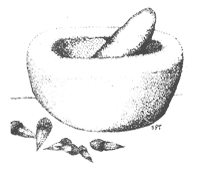 Experts have found that acorns are among the highest forms
of vegetable protein, and they kept the people healthy and strong.
My father's acorn
pancakes are a treat with a very tasty, nutlike flavor. Acorn meal was made into little
cakes placed between two layers of green grass and baked overnight, or used in soups
as a thickener or cooked like a cereal in special cooking baskets. These waterproof
baskets were tightly woven then sealed with tar and pine pitch. Food was put into the
basket with cooking liquid then smooth cooking stones heated very hot were added.
These special cooking stones, handled with looped sticks, were replaced with hot ones
until the mixture boiled. Care was taken to keep the stones moving or the basket could
quickly become a sieve, full of holes!
Experts have found that acorns are among the highest forms
of vegetable protein, and they kept the people healthy and strong.
My father's acorn
pancakes are a treat with a very tasty, nutlike flavor. Acorn meal was made into little
cakes placed between two layers of green grass and baked overnight, or used in soups
as a thickener or cooked like a cereal in special cooking baskets. These waterproof
baskets were tightly woven then sealed with tar and pine pitch. Food was put into the
basket with cooking liquid then smooth cooking stones heated very hot were added.
These special cooking stones, handled with looped sticks, were replaced with hot ones
until the mixture boiled. Care was taken to keep the stones moving or the basket could
quickly become a sieve, full of holes!
All wild berries and fruits were eaten fresh or dried for winter use. Edible roots were baked and enjoyed. Wild onions, garlic and sea kelp, for salt, added flavor. Honey sweetened. Seeds and nuts were gathered, and eaten then, or stored in special small above ground granaries woven from white willow. Acorns were stored in larger granaries of the same type. Dove, quail, squirrel, rabbit, deer, antelope, all were favorite foods, as they still are today.
California was home to the only creatures that were a threat to the people, the
large grizzly bears.
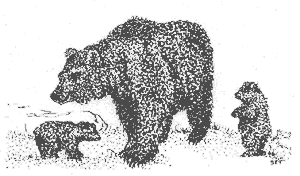 Mother grizzlies with cubs were protective and especially ferocious.
Our great-grandfather made a living as a hunter. He walked everywhere, he had a
horse but never rode it, he used it only for packing. He knew the mountains of the Coast
Range like the back of his hand, but once, when he met a grizzly close up, he did not
tangle with it. He politely and promptly left the area to the bear. He was a wise man.
Mother grizzlies with cubs were protective and especially ferocious.
Our great-grandfather made a living as a hunter. He walked everywhere, he had a
horse but never rode it, he used it only for packing. He knew the mountains of the Coast
Range like the back of his hand, but once, when he met a grizzly close up, he did not
tangle with it. He politely and promptly left the area to the bear. He was a wise man.
During the year triblets or family groups might travel to favorite places to escape summer heat and to hunt, fish or gather certain berries, nuts or herbs when in season. Always, much care was taken not to go beyond the tribal boundaries without express permission. It was up to the neighboring tribe to grant requests for access. This maintained peaceful relations with neighbors for trade. Repetitive stories and songs were used to memorize trees, rocks, streams and other natural objects used as the boundary markers. The tribe knew precisely where its boundaries were, on the coast, from Morro Rock north to Dolan Rock. Inland, our villages were found from Salinas to the Cuesta Grade summit. East, the Diablo Range, Temblor Range and Painted Rock of Carrizo Plain were our boundaries.
California's early people lived by hunting and gathering. They understood how vital it was to conserve plant and animal life to insure a constant food supply. This was done by maintaining a balance between need and availability. In drought years, some native plants that needed more water might not thrive but others took their place, there was always something to eat because the people adjusted their tastes accordingly, just as the wildlife did. The mission system destroyed this natural process by putting in large fields of plants needing cultivation and irrigation. When the people were required to rely on domestic food, the record shows that during droughts or when the crops failed there was hunger, a rarity in ancient times. It was then that those who remembered the old ways would gather wild foods to supplement their diets. Unfortunately, over time, a big part of this precious knowledge was lost.
Before the mission era, the wardrobe of the Salinan man was scanty, in summer he wore nothing but some abalone ear ornaments. In winter he had a fur cape for cold days. Salinans painted themselves but did not wear tattoos, or feathers. Feathers may have decorated baskets, or the shaman's stick and the shaman may have had a single eagle feather worn in his forehead hair but feathers were not worn by most Salinans. The men's hunting wardrobe usually contained a deer skin complete with head and antlers. It was worn over the head and shoulders when hunting deer, enabling them to get closer to their prey.
Women occasionally wore skirts with a panel in front and panel in back, usually made of leather or woven grass or tule fiber. For warmth a cape of woven rabbit fur or tule fiber covered their shoulders, open in front. Children wore nothing until older, then they dressed like the adults. During extreme cold, mud was applied to hold in the body's heat. Their dark thick hair was usually worn long. The men plucked their beards. It is said that Salinans were taller than their neighbors and their women were pretty.
Women were busy caring for their families. Infants were carried in triangular wooden frame cradles. When ready to give birth, the mother was taken to a hut of willow and tule, newly built for the occasion, near a fresh water source. A shallow pit had been dug and lined with heated stones covered with layers of tules and soft pine needles to form a comfortable bed for the mother during labor. After the birth the umbilical cord was cut with a sharp stone and tied with a split tule strand. The baby was immediately bathed in fresh water and wrapped in rabbit skins and strapped into the cradle wearing a soft, pounded grass diaper. The mother and child stayed there for two days then back to the daily routine except that she remained in social seclusion for one month. To ensure good fortune, the father tried not to become angry or offend anyone during this time. When the baby's umbilical cord fell off a celebration feast was given.
Young women were honored for their beauty but more importantly for their modesty. Illegitimacy was rare and usually brought dishonor. Children were lovingly treasured and allowed to run free with few rules. They learned from an early age to use their eyes and ears to observe, to honor others, to be generous, to be useful, brave and dependable. These qualities were learned from examples rather than lectures. Children enjoyed football racing, similar to soccer, shinny which was like field hockey, hoop and pole game where teams threw a spear through a rolling hoop, foot racing, tag and various other games. These games with rules to follow prepared them for adulthood.
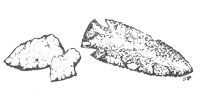 At puberty boys were initiated into manhood by older males through
special rituals. Boys learned to build fires, make bows, arrows, tools and traps. They
gained understanding of the seasons and animal habits and how to dress out game. It
was important that they keep fit, able to run down a deer if necessary, all a part of
survival in a world of hunters. In the men's sweat house were heard songs and stories
relating to the tribe and help in learning to develop their manly power to protect and
provide.
At puberty boys were initiated into manhood by older males through
special rituals. Boys learned to build fires, make bows, arrows, tools and traps. They
gained understanding of the seasons and animal habits and how to dress out game. It
was important that they keep fit, able to run down a deer if necessary, all a part of
survival in a world of hunters. In the men's sweat house were heard songs and stories
relating to the tribe and help in learning to develop their manly power to protect and
provide.
A girl was initiated into the world of womanhood at her first menstruation. Older women led her to the menstruation house where she began to learn about modesty, marriage, sex, birth, and other matters. Under the guidance of these women, the girls also learned womanly duties, they learned where and how to gather foods, how to cook, to process acorns, tan skins, build shelters, design and make basketry, and how to cultivate and use medicinal plants. It took many skills to care for one's family properly.
Adulthood brought membership into one of the two moieties, or social divisions of the people. The moiety was decided by lineage of the father. If the father was a Deer, all his children were Deer. If he was a Bear then his children were of the Bear moiety. Members could not marry someone from their same moiety. Bears could not marry Bears but they could marry Deer, etc.
The people had many songs and dances for all occasions. All that was needed was a reason, such as the completion of a communal project or visitors arriving. Fall and Spring seasonal dances were probably held also. There were dances for men and dances for women. Sometimes they danced in a row of women and then a row of men, taking turns. Music was provided by eight or ten singers with dried cocoon or rattlesnake rattles. Clapper sticks, rasps, flutes and whistles were also used.
The Salinan justice system was based on making the wrong right, restoring things back to the original state, reparation. The offender must admit guilt, acknowledge responsibility and make reparation to the offended one. It was each family's duty to handle its own wrongdoers. The offensive one must change his ways or become an outcast, in extreme cases if an adult proved incorrigible, the family might arrange for a shaman from another tribe to poison him. There would then be no hostility within their family or tribal community. It has been said among them that a person without a family is like being dead, with no one to follow him and no one to trace back to. Family disapproval was a strong deterrent to wrongdoing. It was a hard way, but their survival depended on full cooperation and this way had proved successful for generations.
The tribal healer or shaman was usually male. Cutting open the site and sucking
out the poison was a treatment often used. Herbs and much singing were used in the
healing process. The shaman was believed to possess supernatural powers, even able
to control the rainfall. He was feared and no violence was attempted against him even when he repeatedly lost patients!
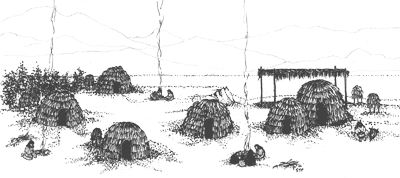
The dead were buried, except for distinguished ones, who were cremated. The ashes were collected and buried and the deceased's name was never spoken again. All possessions, including the house were burnt and the village was abandoned for a short time.
We know that Salinans believed in the Creator and that life was in all things. It is concluded that they did not make or worship effigies as none have been found. In the homeland, rock paintings have been found such as those at the special Painted Cave.
Permanent villages with conical shelters of willow and grass or rushes were built along major rivers and streams of the homeland. Villages were comprised of family groups. Every village had a head man selected for his bravery, who was responsible for the welfare of the people. He was not the "boss" or a dictator, his position was as an arbitrator or advisor. His power was limited by the council of elders and by public opinion. Each individual made his own decision. Everyone had an opportunity to speak and be heard and all of the decisions were based on consensus, everyone agreeing. It took much time and much deliberation to reach a conclusion, just as it does at council meetings now where consensus is still the procedure.
Today, we Salinans are continuing our goal of reconstructing our language and culture and documenting our social and political structure for historical purposes. It is our hope that in time we will be able to recapture and share more fully the history of an ancient and proud, self-sufficient people who have survived in spite of adversities.
These are our honored ancestors, this is our heritage. Yaha'!
Suzanne Pierce Taylor, a Salinan elder and Playaño Salinan descendant lives in
San Luis Obispo, California.
This paper is the result of research sponsored by the Salinan Tribal Council
References and additional reading
A. L. Kroeber
J. A. Mason
A Gutierrez and Richard Orsi
Perouse, lntroduction and commentary by Malcolm Margolin
Robert F. Heizer and Albert B. Elsasser
Betty w. Brusa
R. Costo and Jeanette H. Costo
Beatrice Casey
Zephyrin Engelhardt
Leo C. Sorietsma
archived at Monterey California